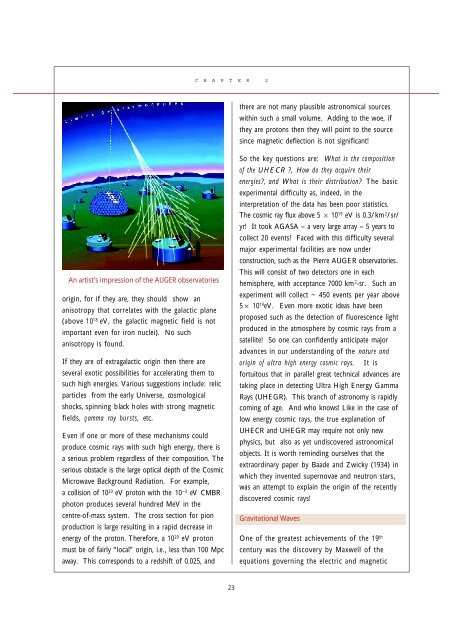2004 ASTRONOMY & ASTROPHYSICS - Indian Academy of Sciences
2004 ASTRONOMY & ASTROPHYSICS - Indian Academy of Sciences
2004 ASTRONOMY & ASTROPHYSICS - Indian Academy of Sciences
Create successful ePaper yourself
Turn your PDF publications into a flip-book with our unique Google optimized e-Paper software.
CHAPTER 2<br />
there are not many plausible astronomical sources<br />
within such a small volume. Adding to the woe, if<br />
they are protons then they will point to the source<br />
since magnetic deflection is not significant!<br />
An artist’s impression <strong>of</strong> the AUGER observatories<br />
origin, for if they are, they should show an<br />
anisotropy that correlates with the galactic plane<br />
(above 10 18 eV, the galactic magnetic field is not<br />
important even for iron nuclei). No such<br />
anisotropy is found.<br />
If they are <strong>of</strong> extragalactic origin then there are<br />
several exotic possibilities for accelerating them to<br />
such high energies. Various suggestions include: relic<br />
particles from the early Universe, cosmological<br />
shocks, spinning black holes with strong magnetic<br />
fields, g amma ray bursts, etc.<br />
Even if one or more <strong>of</strong> these mechanisms could<br />
produce cosmic rays with such high energy, there is<br />
a serious problem regardless <strong>of</strong> their composition. The<br />
serious obstacle is the large optical depth <strong>of</strong> the Cosmic<br />
Microwave Background Radiation. For example,<br />
a collision <strong>of</strong> 10 20 eV proton with the 10 –3 eV CMBR<br />
photon produces several hundred MeV in the<br />
centre-<strong>of</strong>-mass system. The cross section for pion<br />
production is large resulting in a rapid decrease in<br />
energy <strong>of</strong> the proton. Therefore, a 10 20 eV proton<br />
must be <strong>of</strong> fairly “local” origin, i.e., less than 100 Mpc<br />
away. This corresponds to a redshift <strong>of</strong> 0.025, and<br />
So the key questions are: What is the composition<br />
<strong>of</strong> the UHECR ?, How do they acquire their<br />
energies?, and What is their distribution? The basic<br />
experimental difficulty as, indeed, in the<br />
interpretation <strong>of</strong> the data has been poor statistics.<br />
The cosmic ray flux above 5 × 10 19 eV is 0.3/km 2 /sr/<br />
yr! It took AGASA – a very large array – 5 years to<br />
collect 20 events! Faced with this difficulty several<br />
major experimental facilities are now under<br />
construction, such as the Pierre AUGER observatories.<br />
This will consist <strong>of</strong> two detectors one in each<br />
hemisphere, with acceptance 7000 km 2 -sr. Such an<br />
experiment will collect ~ 450 events per year above<br />
5 × 10 19 eV. Even more exotic ideas have been<br />
proposed such as the detection <strong>of</strong> fluorescence light<br />
produced in the atmosphere by cosmic rays from a<br />
satellite! So one can confidently anticipate major<br />
advances in our understanding <strong>of</strong> the nature and<br />
origin <strong>of</strong> ultra high energy cosmic rays. It is<br />
fortuitous that in parallel great technical advances are<br />
taking place in detecting Ultra High Energy Gamma<br />
Rays (UHEGR). This branch <strong>of</strong> astronomy is rapidly<br />
coming <strong>of</strong> age. And who knows! Like in the case <strong>of</strong><br />
low energy cosmic rays, the true explanation <strong>of</strong><br />
UHECR and UHEGR may require not only new<br />
physics, but also as yet undiscovered astronomical<br />
objects. It is worth reminding ourselves that the<br />
extraordinary paper by Baade and Zwicky (1934) in<br />
which they invented supernovae and neutron stars,<br />
was an attempt to explain the origin <strong>of</strong> the recently<br />
discovered cosmic rays!<br />
Gravitational Waves<br />
One <strong>of</strong> the greatest achievements <strong>of</strong> the 19 th<br />
century was the discovery by Maxwell <strong>of</strong> the<br />
equations governing the electric and magnetic<br />
23
















